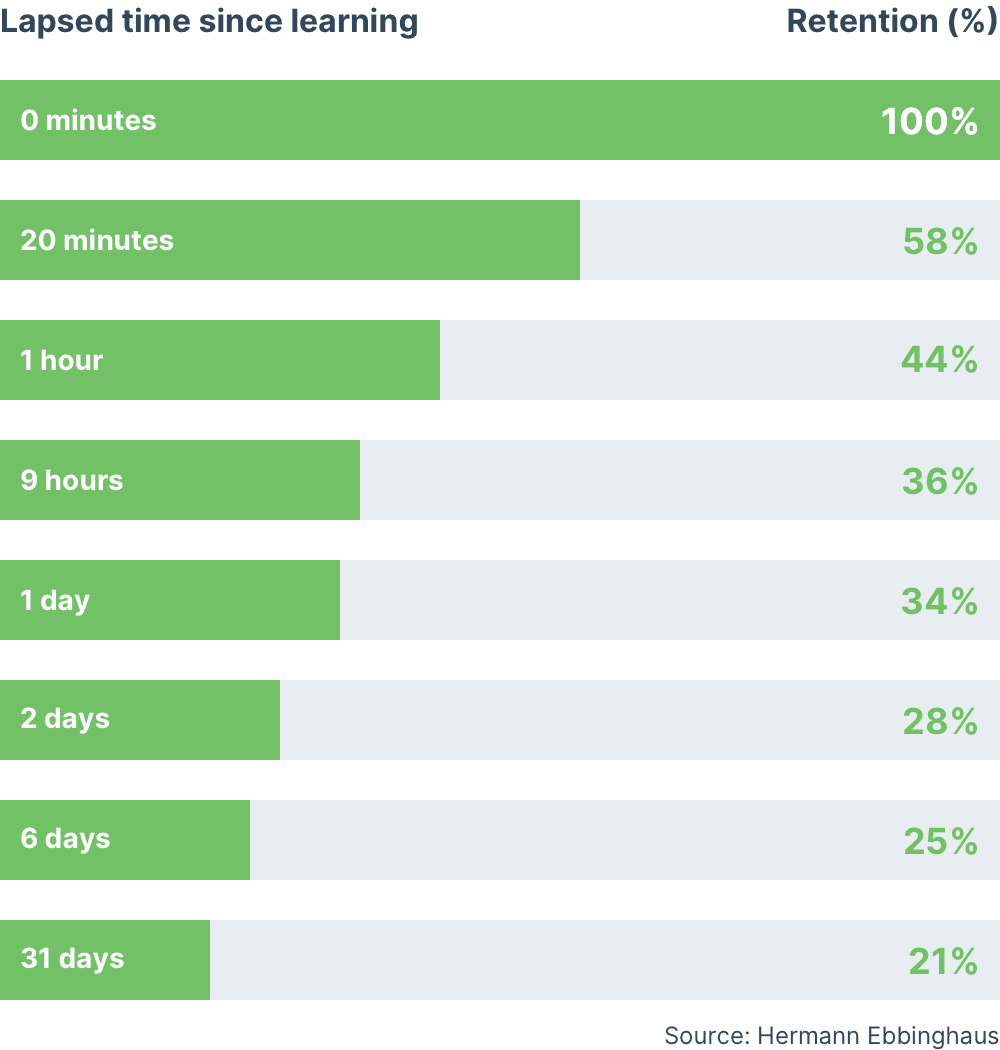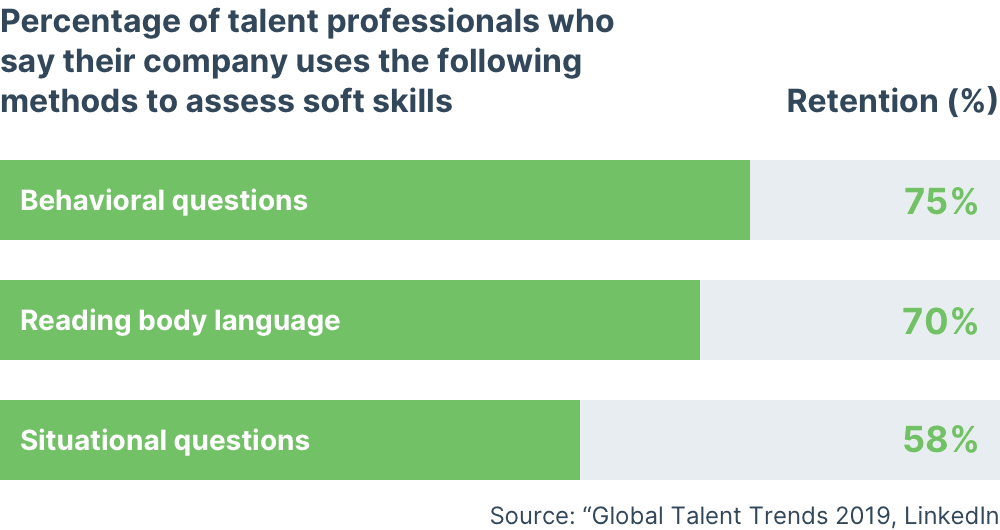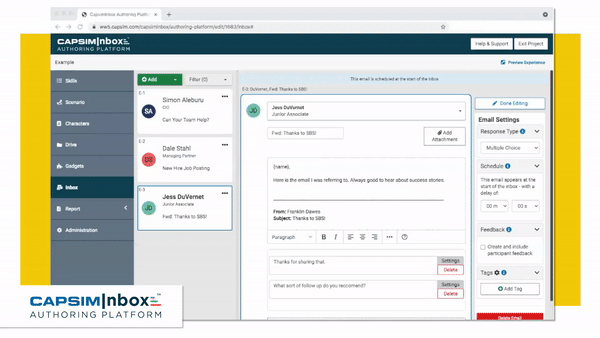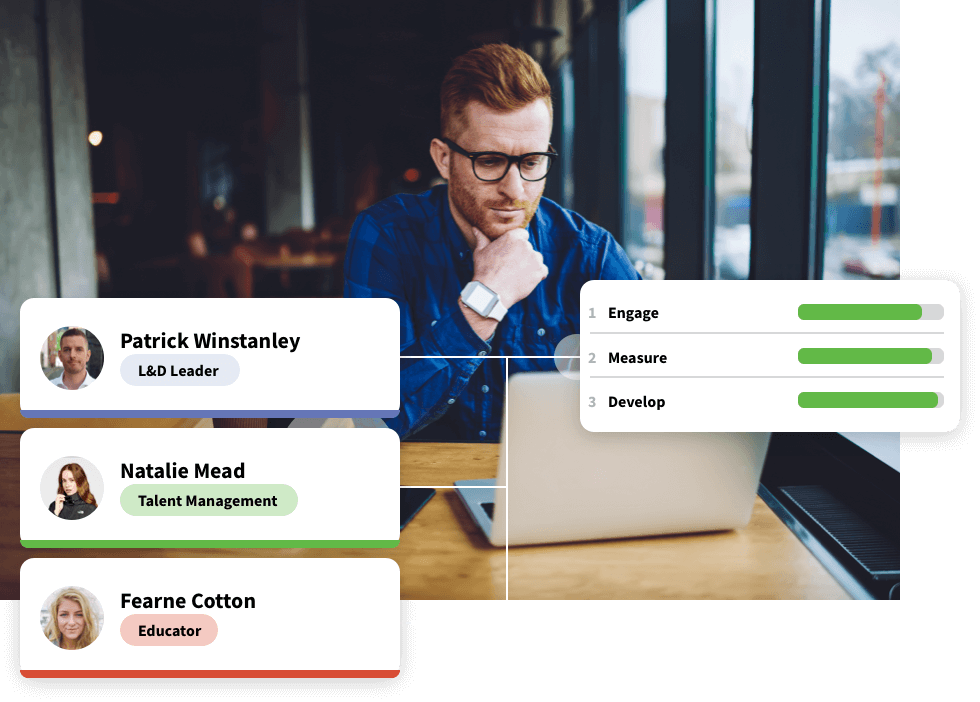Start Building Real-World Skills
Using Simulations for Soft Skill Development in 2022 and Beyond
Your people can be your competitive advantage. Here's how to help them develop their soft skills and make progress to become the best version of themselves.
Three trends are shifting the ground of the modern business landscape.
First, automation and artificial intelligence are being used for jobs traditionally done by people, moving those same people into positions to oversee those systems.
Second, there is growing parity in technology and technical skills across industries.
And third, the world and everyone in it is more connected than ever.
In this situation, how do you develop a competitive advantage and deliver a customer experience that makes you deserving to win in your market?
Your people.
More specifically, how your people perform on the job, collaborate with their teammates, and interact with customers and potential customers.
The companies who will win in this decade will be technological innovators in their given space. But winning also demands investing in soft skill development that is measurable, both in terms of team development and in your bottom line.
You need a validated, proven method to develop soft skills.
A Validated, Proven Tool for Soft Skill Development
Soft Skill Development is Crucial to Gaining a Competitive Advantage
Learning and development professionals are on the hot seat when it comes to soft skills.
Companies have long known that how their employees work together and interact with those outside the company would become vital to success. One study after another revealed soft skills development as the top priority for companies:
- An IBM study found that CEOs ranked investment in people as the #1 way to accelerate performance. 1
- A 2018 LinkedIn study identified developing soft skills as the #1 priority for companies.2
- A separate 2019 LinkedIn survey found a whopping 92 percent of hiring and talent professionals said soft skills matter more than hard skills.3
- A 2021 America Succeeds analysis showed the top five soft skills were requested nearly 4X more than the top five hard skills across 82 million job postings.4
Yet despite knowing how important soft skills are and saying developing soft skills is the #1 priority, they are still notorious for being “hard to train” and “difficult to measure.”
But that’s blaming an easy target for the failures that belong elsewhere.
It’s not that companies were doing things wrong. It’s that the right solution — one that’s evidence-backed, validated, and offering an engaging and relevant experience to learners — was missing.
The real blame for the lack of traction and progress in soft skills training lies with the outdated and ineffective methods and tools offered as “silver bullets.”
Traditional Training and Assessment Methods Won’t Cut it Anymore
How would you feel if only 12 percent of your employees said they could apply what they’ve been taught in your company’s training? It would be a stiff karate chop to your ego as an L&D professional.
Yet that’s exactly what a 24x7 Learning report found in 2015.5
Another 2015 study from ATD Research showed only 38 percent of managers believed their company’s training initiatives met their learner’s needs.6
The big question is, "why?"
As humans, we forget what we learn quickly.
Hermann Ebbinghaus, a German psychologist, found in the late 1800s that unless we apply new information, we’ll forget about 75 percent of it after only six days.7
This is especially pertinent because the most popular training methods lack a channel for knowledge application.
Video libraries, Powerpoint lectures, and in-person seminars focus on knowledge acquisition and retention.
Yet studies have shown that a only a very small portion of knowledge acquired (19%) can be skillfully applied.8


But the problem doesn’t only exist in corporate training programs.
Hiring is similarly affected by outdated methods for assessing soft skills.
A LinkedIn survey of over 5,000 talent professionals found hiring and talent managers rely heavily on ineffective assessment methods to assess soft skills in interviews.3
These methods haven’t changed in decades, are prone to subjectivity and bias, and can easily be coached or studied for (just Google “situational interview questions” or “interview body language coaching”). They aren’t true, objective measures of a candidate’s soft skill proficiency.
Traditional methods for assessing and developing soft skills are outdated.
It’s impossible to develop a competitive advantage through soft skills training if:
- You can’t accurately identify current skills and skill gaps.
- Your instruction methods don’t include knowledge application.
But what about newer methods and tech-based tools?
Modern tools and methods have their faults as well
When evaluating soft skills training tools and methods, there are four criteria a soft skills the developmental platform should meet:
- Includes avenues for applying soft skills in a real-world situation.
- Is engaging and relevant to your learners.
- Helps develop self-awareness of soft skill gaps
- Includes channels for direct, actionable feedback.
With that in mind, let’s look at the positive and negative attributes of some of today’s favored tools for developing soft skills.
Virtual Reality
Virtual reality simulations offer a very immersive and engaging experience for learners. It also takes a long time to code and develop just one VR simulation at a hefty price tag. Plus, some may experience motion sickness or other minor health issues using VR.
✅Includes avenues for applying soft skills in a real-world situation.
✅Is engaging and relevant to your learners.
❌Helps develop self-awareness of soft skill gaps
✅Includes channels for direct, actionable feedback.
E-learning & Authoring Tools
These platforms offer a richer, more dynamic learning experience than a typical Powerpoint or lecture-based presentation, and can be used to build a scenario-based training module. However, e-learning & authoring platforms lack immersiveness and a real-world environment, which diminishes learning transfer to on the job performance.
❌Includes avenues for applying soft skills in a real-world situation.
❌Is engaging and relevant to your learners.
❌Helps develop self-awareness of soft skill gaps
❌Includes channels for direct, actionable feedback.
Video Libraries
Training libraries of video content are a popular way to go for many companies. On-demand video is slightly more engaging than a lecture, is self-directed, and puts the timing in your employees’ hands.
However, video libraries can be rather expensive, often go unused/underused, and put the onus on the employee to spend hours watching video content without a way to apply what they’re learning.
❌Includes avenues for applying soft skills in a real-world situation.
✅Is engaging and relevant to your learners.
❌Helps develop self-awareness of soft skill gaps
❌Includes channels for direct, actionable feedback.
In-Basket Activities
An in-basket activity is a physical simulation of what it’s like to receive documents, mail, messages, and memos, set priorities, and start responding. They are a popular method for assessing soft skills because they are engaging, relevant, and evidence-backed.
However, they are expensive and come with a long waiting period between completing the activity and getting your results. This makes in-basket activities unscalable.
✅Includes avenues for applying soft skills in a real-world situation.
✅Is engaging and relevant to your learners.
✅Helps develop self-awareness of soft skill gaps
❌Includes channels for direct, actionable feedback.
The “Aha!” moment: how the idea to use simulations for soft skills was born
An in-basket activity spurred the creation of our own soft skills training platform.
A few years ago, we created a soft skills development initiative for our internal managers. At the same time, we were in the midst of a separate program with our upper-level management working on strategic decision-making.
We knew both initiatives needed to engage our two learning groups and give them the chance to apply their knowledge and current skills. Being based in Chicago, we found out that nearby DePaul University offered in-basket activities, so we enrolled our team members in the activity.
While the outcomes were what we wanted, problems crept up as we started thinking about putting more of our staff through these activities.
- Cost - the results were great, but the cost meant there would be no way we could put our entire team through in-basket activities.
- Time investment - in-basket activities take half a day to complete.
- Proximity to a provider - we were lucky to be near DePaul University, but most businesses aren’t close to a quality provider.
- Waiting time - results aren’t delivered immediately, but rather weeks later, so you aren’t capitalizing on momentum right after the activity.
While a great tool, we realized in-basket activities wouldn't be scalable enough to use across our company. But we also found other methods like mock interviews, situational training, and VR/AR to be too resource-intensive for us.
We were in a bind...until our “aha!” moment.
In an in-basket activity, you receive physical messages (mail, memos, etc.), prioritize your work, and then execute. That seemed pretty similar to company email and messaging. You receive emails and messages from co-workers, prioritize which are the most pressing, and respond.
Plus, there were two trends from that time we could capitalize on:
- A rash of studies and surveys all saying soft skill development would be crucial as more companies began to rely on automation and AI.
- The popularity of online learning platforms like Udemy, Lynda, and even YouTube.
So we thought...
“Why not create an email-based tool to assess soft skills in the digital world?”

Free Demo & Pilot Account
Build your first simulation. It's as easy as writing emails.
Making simulation-based learning stick
We knew simulations were a key tool in helping learners engrain their lessons. We’d been using them in executive education for decades and studies consistently proved this, like a landmark study from 2011 showing simulation-based learning:
- Increased self-efficacy by 20 percent
- Increased knowledge acquisition by 11 percent
- Increased knowledge application by 14 percent
- And increased knowledge retention by 9 percent10


To ensure our email-based simulations could actually help learners improve their soft skills over time (and could show it), we started with the weaknesses of other soft skill training methods and tools.
- It couldn’t just be about acquiring knowledge, but applying it in scenarios identical to those employees would face in real life.
- It had to be engaging and immersive to hook learners, ingrain their lessons, and connect simulations to their work.
- It had to help develop self-awareness by measuring how learners rated their soft skills and comparing their ratings to how they perform in the simulations.
- Must incorporate direct, actionable feedback that helps employees progress over time (shockingly, over one-third of feedback provided to learners negatively impacts their performance and engagement9).
With these key criteria in mind, we set out to create a soft skills training and assessment platform that could give both L&D and their learners the tools to train and measure soft skill development over time.
The result? CapsimInbox
CapsimInbox provides the familiarity and flexibility of an email inbox while checking all the boxes for a top-tier soft skills development platform.
Includes avenues for applying soft skills in a real-world situation.
The guiding principle of CapsimInbox is to deliver “day-in-the-life” simulations mirroring real-world situations.
This isn’t simply a test or quiz to check for understanding. CapsimInbox simulations put learners through the demands and challenges in a digital role-play of authentic work scenarios.
Engaging and relevant to your learners.
The compelling story-based approach of inbox simulations brings in emotions, engaging the brain and eliciting activity in brain centers responsible for empathy, compassion, and trust.
CapsimInbox’s flexibility helps you tailor simulations to your learners. It’s not a one-size-fits-all library of videos or a Powerpoint presentation that takes hours to get through.
Instead, CapsimInbox sessions can be delivered in 10 to 30 minutes in a game-like email interface that’s easy for your employees to learn.
Helps develop self-awareness of soft skill gaps.
Most assessment tools rely only on a learner’s self-ratings of their proficiencies.
CapsimInbox includes a self-rating tool but then compares the self-rating with actual performance. It delivers the insights via a visual dashboard that shows any skill gaps a learner may have.
Includes channels for direct, actionable feedback.
What gets measured gets improved.
CapsimInbox simulations go beyond right-wrong grading. When your employees complete a simulation, they receive a report with four different measures:
- Overall Score - rates the speed and accuracy of responses in the simulation. The Overall Score displays as a percentile comparing their performance against our entire database of users.
- Developmental Index - shows the current skill proficiency levels across the measured skills and how consistently these levels were demonstrated in the simulation.
- Self-Awareness - reflects how accurately the learner’s self-assessment matches their performance from the simulation, with higher scores indicating better self-awareness.
- Skill Gaps - displays the learner’s self-assessment and the objective scores from the simulation across measured skills.
This reporting helps your learners check their performance, measure progress, and better understand their soft skill development. Plus, growth and progress are key to keeping employees engaged in their training.
But here’s the big question...does it work?
Will CapsimInbox actually help you assess and develop your team’s soft skills?
To test the effectiveness of our simulations for soft skill development, we implemented two separate validation measures.
Content-Related Validity
Content-related validity assesses whether the content of a test, survey, or measurement method covers all the necessary and relevant aspects of the subject being measured.
In other words, does the assessment cover a given topic thoroughly?
We took a two-pronged approach to validation for the content within CapsimInbox.
- We looked at existing academic and practitioner studies to identify the content and soft skills measured within CapsimInbox to ensure the identified soft skills could be measured effectively.
- We sought additional evidence using subject matter expert reviews in a four-step process administered by PhD-level industrial-organizational psychologists. The results:
- CapsimInbox - General Management scored 99 percent
- CapsimInbox - People Management scored 100 percent
- CapsimInbox - Ethical Decision Making scored 97 percent
Taken collectively, these results provide strong evidence for the content-related validity of CapsimInbox.
Review the detailed synopsis of our content-related validity here.Criterion-Related Validity
Criterion-related validity looks at whether scores from an assessment connect with important outcomes. An assessment can predict meaningful outcomes when you find strong evidence of criterion-related validity.
The results of this validation test? Assuming you have relevant and quality content (which we validated we do), CapsimInbox effectively and objectively measures those skills and can also be a valid predictor of on-the-job performance.
The only thing proven to be more accurate than CapsimInbox simulations is an actual work sample.
Review the detailed synopsis of our criterion-related validity here.
The path forward: CapsimInbox Simulations for Soft Skill Assessment & Development
The focus of L&D in the future of companies is squarely on upskilling and reskilling employees as job descriptions and jobs themselves are shaped by technology, AI, and hybrid or permanent work-from-home trends. Soft skills like critical thinking, organization, problem-solving, and leadership are at the top of the list.11
A rapidly changing workplace requires a radically different approach to assessing and developing critical soft skills across their organization. Yet, 40 percent of corporate training in 2020 was delivered via instructor-led methods.11
These methods alone are not good enough. Not with expectations so high for L&D leaders and their initiatives:
- 81 percent of executives say talent is the number one priority at the company
- 90 percent say that L&D is a necessary benefit to the employees at the company.12
This high praise comes with a caveat: the need for demonstrable, real progress that directly impacts the company.
Relying solely on soft skill development methods and tools that don’t:
- Engage learners...
- Help them ingrain concepts and lessons via knowledge application...
- Help them become self-aware of their skills...
- Include direct, applicable feedback...
Is a fool’s errand.
Independent research has shown simulations to be a valuable and effective addition to corporate training programs, helping employees engrain their learning through knowledge application.
And third-party validation has shown CapsimInbox to be one of the most effective vehicles for assessing and developing soft skills within your organization. Using our simulations for soft skill development just works.
Want to see it for yourself?
Our free demo and pilot account gives you instant access to our pre-built simulations and our simulation authoring platform. You’ll be able to start building authentic, day-in-the-life simulations just by writing emails and instant messages (no coding required).
Winning in the decade ahead is reserved for companies who maximize the impact of their people. Leveling up soft skills and building an A+ workforce that drives company growth is your #1 priority.
CapsimInbox was built for this moment. Take it for a test drive for free now to see the value CapsimInbox can add to your L&D tech stack firsthand.

Start for Free Today!
Get your no-obligation demo and pilot account to see how easy it is to use CapsimInbox.